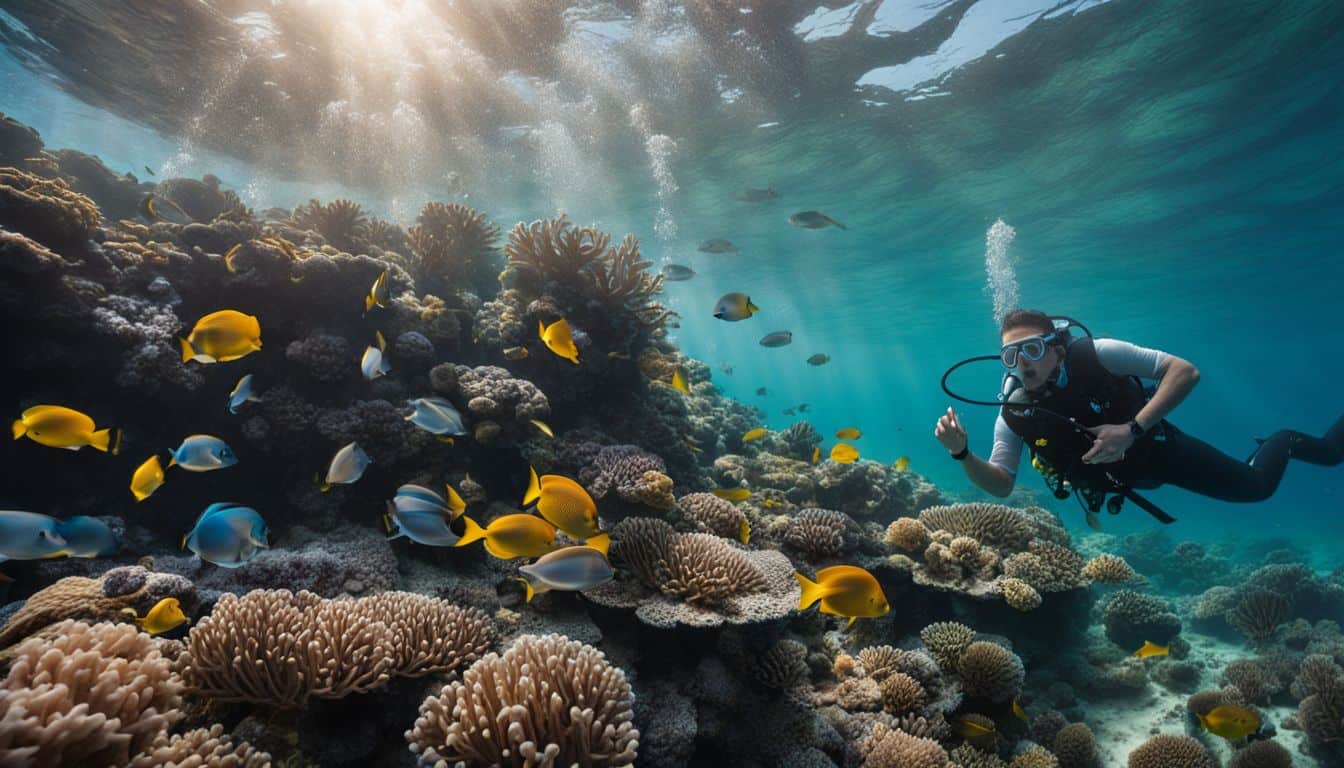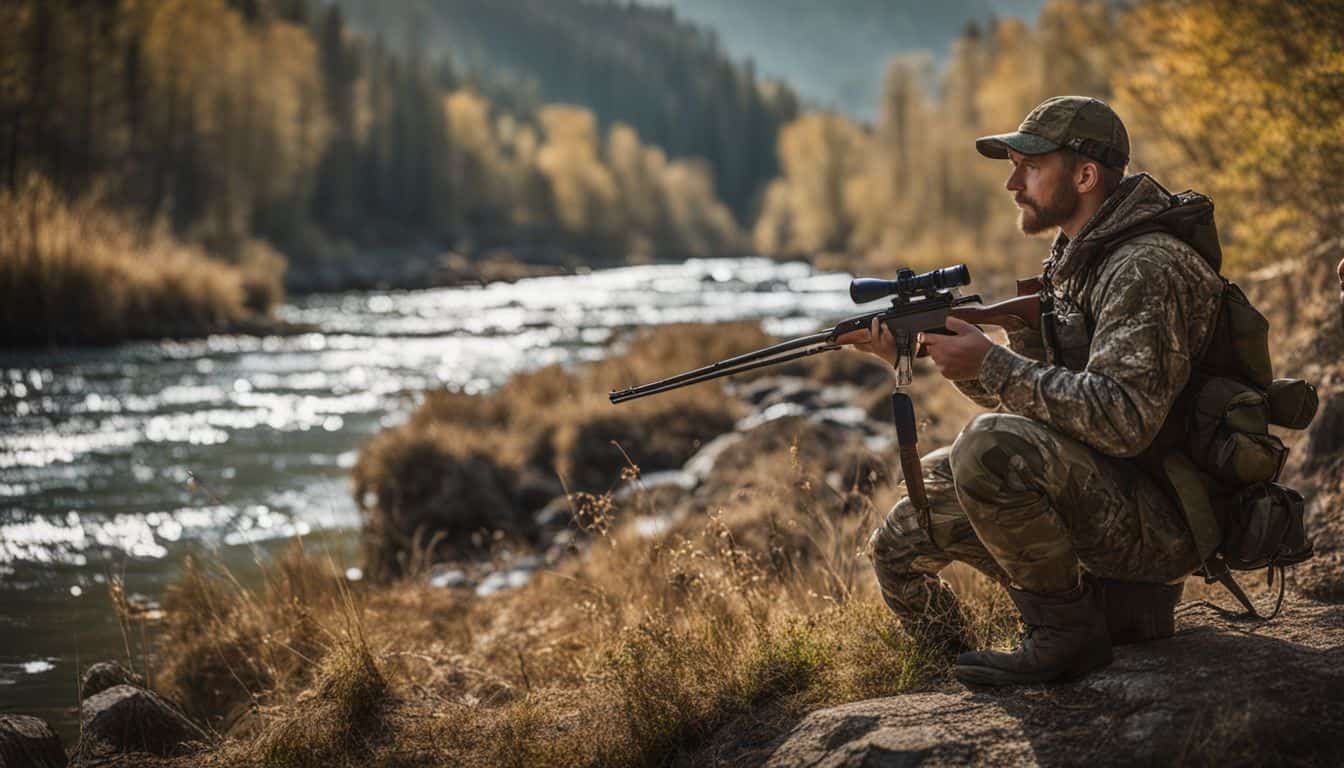Just like you, I’ve stayed awake at night, fretting over the dire effects of overfishing and unsustainable hunting on our precious environment. It can feel overwhelming, right? But there’s hope! Multiple research studies indicate that by embracing sustainable fishing methods, we hold the power to rejuvenate fish populations and secure marine biodiversity for future generations.
In this blog post, we’ll navigate you through three practical strategies to champion sustainable hunting and fishing – a hands-on approach helping you contribute positively towards worldwide conservation work.
Ready to jump aboard in our voyage towards sustainability?
Key Takeaways
- Sustainable hunting and fishing mean taking only what nature can replace, preserving fish populations and marine biodiversity for future generations.
- Overfishing disrupts the food chain, causes harmful algal blooms, leads to bycatch issues, and creates imbalanced ecosystems.
- Solutions for overfishing include implementing rights – based fishery management, regulating fishing methods, establishing traceability standards, creating marine protected areas, and enacting fish farm standards and reforms.
Basics of Sustainable Hunting and Fishing
Sustainable hunting and fishing mean taking only what nature can replace. It’s like using a bank account of wild things in a smart way. I follow these rules when I hunt, fish, or trap in New York.
Let’s keep a lot of each type of fish and animal for the future.
Using lead-free bullets helps my hunting stay clean. Lead is bad for birds who might eat it by accident. Taking more females than males is also a no-no in hunting. Babies need their moms! Hunting too much can hurt all the animals we share our world with.
The Effects of Overfishing on the Environment
Overfishing wreaks havoc on the environment by disrupting the food chain, causing harmful algal blooms, leading to bycatch issues, and creating imbalanced ecosystems.
Disruption of the food chain
Overfishing hurts the food chain badly. It takes away too many fish that other sea animals need to eat. This change causes more than an empty belly. When one part of the food chain changes, everything else shifts too.
This is called a cascade effect.
Ocean life gets turned upside down when overfishing happens. Big fish can’t find enough food because smaller fish are gone. To survive, they have to eat different things or move to new places.
Some types of ocean wildlife can even vanish for good!
These big changes create problems in marine ecosystems far and wide. The loss of biodiversity is a tough break for our oceans and our planet.
Harmful algal blooms
Harmful algal blooms can harm our seas and lakes. They happen when too much algae grows in the water. This often happens because of things we do, like using too much fertilizer or soap that gets into the water.
The winds and currents in the sea or lake can also make this problem worse. When there’s too much algae, it blocks sunlight. This hurts other plants and animals living under the water that need sunlight to live well.
Another big problem with these blooms is seafood safety. Sometimes, they produce harmful toxins that build up in fish and shellfish we might want to eat later on. It’s not safe to eat seafood from waters where harmful algal blooms happened recently.
So sometimes, areas have to stop all fishing for a while until it becomes safe again.
We must find ways to slow down these harmful algal blooms as part of saving our seas and lakes from damage caused by overfishing.
Bycatch issues
Bycatch is a big problem in fishing. It happens when non-target species are accidentally caught while trying to catch something else. This is because fishing gear isn’t very selective, so it catches more than just the intended fish.
Bycatch is a serious threat to marine ecosystems and can have harmful effects on both the targeted and non-targeted species. It can lead to imbalanced ecosystems and disrupt the delicate balance in marine environments.
Bycatch needs to be addressed in order to protect our oceans and ensure sustainable fishing practices.
Imbalanced ecosystems
Imbalanced ecosystems are a serious consequence of overfishing. When too many fish are taken from the ocean, it disrupts the delicate balance within the ecosystem. This disruption affects both lower and upper trophic levels, causing problems throughout the food chain.
Without enough fish to eat, predators may struggle to survive, while an excess of prey can lead to harmful algal blooms. Imbalance in these ecosystems can have far-reaching effects on other wildlife and plants that depend on them for survival.
In 2017 alone, one-third of global fish stocks were overfished, highlighting the urgency for sustainable hunting and fishing practices to restore balance and protect our oceans.
Solutions for Overfishing
To address the issue of overfishing, various solutions can be implemented such as rights-based fishery management, regulating fishing methods, implementing traceability standards, establishing marine protected areas, and enacting fish farm standards and reforms.
Rights-based fishery management
Rights-based fishery management is a solution to overfishing that can help save our oceans. By prioritizing sustainability in hunting and fishing practices, it gives fishermen the rights and responsibilities to manage their own fish stocks.
This means they have a stake in keeping the population healthy for future generations. With rights-based fishery management, we can reverse the overfishing crisis and ensure that marine resources are protected for years to come.
It’s important for world leaders to encourage sustainable fisheries management and implement conservation measures like this one.
Regulating fishing methods
Regulating fishing methods is crucial for sustainable hunting and fishing practices. It helps protect the future populations of ocean and freshwater wildlife. Here are some important ways in which regulating fishing methods can make a positive impact:
- Implementing regulations on fishing nets: By setting standards for the size and type of fishing nets used, we can prevent the capture of undersized or endangered species.
- Restricting certain fishing techniques: Some fishing methods, like bottom trawling or purse seining, can cause significant damage to the seabed or result in large amounts of bycatch. Regulations can limit or ban these harmful practices.
- Establishing catch limits: Setting quotas or limits on how much fish can be caught helps prevent overfishing and ensures that fish populations have a chance to reproduce and replenish.
- Requiring selective gear: Using gear that allows smaller or non-targeted species to escape while catching only the desired species reduces bycatch and helps maintain balanced ecosystems.
- Protecting sensitive habitats: Regulations can designate areas as marine protected areas, where certain types of fishing are restricted or prohibited altogether. This helps protect fragile habitats and allows them to recover.
Implementing traceability standards
To make sustainable hunting and fishing possible, implementing traceability standards is crucial. Here are some key reasons why:
- Verify environmental and social performance: Traceability allows us to ensure that seafood products are sourced in a way that protects the environment and supports social well-being.
- Prevent illegal catches: By tracking fish from catch to consumer, we can prevent illegal catches from entering the market through opaque supply chains.
- Mitigate risks related to food safety: Traceability helps identify and address potential issues with seafood products, ensuring they meet food safety standards and protecting consumers’ health.
- Protect human welfare: Implementing traceability standards promotes fair labor practices, ensuring that workers involved in fishing and seafood processing are treated ethically.
- Enhance environmental sustainability: With traceability, we can better understand the impact of fishing activities on marine ecosystems, allowing for targeted conservation measures and sustainable resource management.
Establishing marine protected areas
As a survival enthusiast, I understand the importance of protecting our oceans and its resources. One effective solution to combat overfishing is by establishing marine protected areas (MPAs). Here’s why MPAs are crucial for sustainable hunting and fishing:
- MPAs safeguard marine environments: By designating specific areas where fishing is prohibited, MPAs help protect sensitive habitats and ecosystems. This preservation allows marine life to flourish and helps maintain biodiversity.
- MPAs promote sustainable fisheries: By limiting or prohibiting fishing activities in certain areas, MPAs allow fish populations to replenish and grow. This ensures the long-term sustainability of fisheries, preserving them for future generations of hunters and anglers.
- MPAs support ecosystem-based management: Healthy ecosystems are essential for thriving fish populations. By establishing MPAs, we can achieve a balanced ecosystem that benefits not just the target species but also their surrounding habitats and associated wildlife.
Fish farm standards and reforms
Fish farm standards and reforms are important for promoting sustainable hunting and fishing. Here are some key ways they can help:
- Implementing stricter regulations: By setting clear guidelines and regulations for fish farms, we can ensure that they operate in an environmentally responsible manner. This includes measures to reduce pollution, prevent escapes of farmed fish into the wild, and minimize the use of antibiotics and other chemicals.
- Improving fish welfare: Fish farmed in crowded or stressful conditions can suffer from poor health and increased susceptibility to disease. By implementing higher standards for fish welfare, such as providing adequate space and good water quality, we can ensure that farmed fish are treated humanely.
- Promoting sustainable practices: Some fish farms use unsustainable practices like netting wild fish to feed their stock or clearing mangroves for shrimp ponds. By encouraging farms to adopt more sustainable methods, such as using plant-based feeds or recirculating water systems, we can reduce their impact on wild ecosystems.
- Encouraging transparency: Consumers have a right to know where their seafood comes from and how it was produced. By implementing traceability standards for fish farms, we can provide consumers with information about the origin of their seafood and whether it was produced in an environmentally responsible way.
- Supporting research and innovation: Continued investment in research and development is critical for improving the sustainability of fish farming. This includes exploring new technologies, such as offshore farms or closed-containment systems, that have the potential to reduce environmental impacts and increase efficiency.
International fishing regulations
International fishing regulations play a critical role in addressing the problem of overfishing and ensuring the long-term sustainability of fish populations. These regulations consist of three main strategies:
- Rights-based fishery management: This approach involves allocating fishing rights to individuals or groups. By giving fishermen specific quotas or limits, it helps prevent overfishing and promotes responsible harvesting practices.
- Regulating fishing methods: Setting rules and restrictions on fishing techniques is another important aspect of international fishing regulations. By controlling how fish are caught, such as banning certain destructive methods like bottom trawling, we can reduce unintended harm to marine habitats and non-target species.
- Traceability standards: Ensuring the traceability of fish products is crucial for promoting sustainable fisheries. With traceability measures in place, consumers can have confidence that their seafood comes from well-managed stocks and legal sources, discouraging illegal, unreported, or unregulated fishing practices.

Education and Awareness for Overfishing
Education and awareness play a crucial role in addressing the issue of overfishing and promoting sustainable hunting and fishing practices. It is important to understand the impact of our actions on the environment, especially when it comes to fishing.
Overfishing depletes fish populations, disrupts ecosystems, and threatens marine biodiversity.
By educating ourselves about the consequences of overfishing, we can make informed choices about what seafood to consume and support sustainable fisheries. We can also spread awareness among our friends, family, and communities about the importance of sustainable fishing practices.
Together, we can help protect our oceans for future generations.
It’s essential that we learn about sustainable seafood options and look for certifications like Marine Stewardship Council (MSC) or Aquaculture Stewardship Council (ASC) labels when buying seafood products.
By making conscious decisions as consumers, we can encourage responsible fishing practices.
Through education and spreading awareness, we have the power to make a positive impact on our oceans’ health by supporting sustainable hunting and fishing practices. Let’s work together to ensure a future where both humans and wildlife thrive in harmony.
Reforms in Fishing Subsidies
To ensure sustainable hunting and fishing practices, it is crucial to address the issue of fishing subsidies. These government subsidies often contribute to overfishing and the depletion of fish populations.
In order for fishers to thrive in the long term, we need to reduce our reliance on these subsidies and instead focus on sustainable fishing methods.
Reforming fishing subsidies is essential because they have a negative impact on both coastal ecosystems and the overall health of our planet. By reducing or eliminating harmful fisheries subsidies, we can encourage fishers to adopt more sustainable practices that protect marine biodiversity and promote ecosystem health.
This reform would involve redirecting financial support away from activities that contribute to overexploitation and resource depletion. Instead, funds could be allocated towards initiatives such as conservation efforts, research into sustainable fishing techniques, or even assisting fishers in transitioning towards alternative livelihoods.
In conclusion, addressing the issue of fishing subsidies is a critical step in achieving sustainable hunting and fishing practices. By reforming these subsidies, we can incentivize fishers to prioritize conservation over short-term gains while working towards protecting our precious marine resources for future generations.
Protection of Essential Predators
Protecting essential predators is crucial for maintaining the ecological balance in our ecosystems. These predators play a vital role in controlling the population of other species, ensuring that no one species becomes too dominant.
By keeping prey populations in check, essential predators help maintain healthy and stable ecosystems.
One important way to protect essential predators is through sustainable hunting practices. Regulated hunting can be an effective tool for managing predator populations and preventing overpopulation.
By carefully selecting the number of predators to harvest each year, wildlife management authorities can ensure that their numbers remain at a sustainable level.
Conservation efforts also play a significant role in protecting essential predators. Creating protected areas where these animals can thrive without disturbance helps safeguard their populations.
Additionally, implementing fishing regulations that limit bycatch and protect predator species indirectly contribute to their preservation.
Overall, it’s important to recognize the value of essential predators and take steps to protect them. Without them, our ecosystems would lack balance and stability, leading to negative consequences for both wildlife and humans alike.
So let’s work together to conserve these incredible creatures and preserve the natural world we all depend on.
Agricultural Investment and Reforms
Agricultural investment and reforms are crucial for creating sustainable farming practices. This means using methods that have positive impacts on the environment, animals, and people.
In recent years, policymakers have recognized the importance of these investments and committed to making significant changes. For example, the 2023 Farm Bill platform aims to provide income opportunities and fairness for small and mid-sized family farms while also rewarding agricultural practices that conserve soil.
Successful agricultural transformations focus on giving farmers better income opportunities so they can improve their livelihoods. By investing in agriculture and implementing reforms, we can create a more sustainable future for all.
The Importance of Sustainable Hunting and Fishing Practices
As a survival enthusiast, I understand the importance of sustainable hunting and fishing practices. Conservation is crucial to maintaining healthy wildlife populations and protecting our ecosystem.
By practicing responsible fishing and ethical hunting, we ensure that our resources are used sustainably for future generations.
Sustainable hunting involves managing wildlife populations carefully. This means only taking what is needed and following laws and regulations set in place to protect endangered species.
By doing so, we help maintain biodiversity and ecological balance in our environment.
Similarly, sustainable fishing practices focus on preserving fish stocks and minimizing harm to marine life. This includes using selective fishing methods that reduce bycatch (unintended catch), adhering to sustainable seafood guides when making choices about what to consume, preventing ocean waste such as ghost nets or plastic pollution, and supporting the establishment of marine protected areas.
By embracing these conservation-minded practices both in hunting and fishing activities, we can contribute to the long-term health of our natural resources while enjoying the benefits they provide us.
Benefits of Conservation-minded Hunters and Anglers
As a survival enthusiast, you may wonder about the benefits of conservation-minded hunters and anglers. Well, let me tell you! These individuals play a crucial role in supporting sustainable hunting and fishing practices.
They contribute to wildlife conservation efforts, helping to preserve and manage populations of animals.
One important benefit is that hunting and fishing provide a source of nutrition. When hunters harvest animals, they can consume the meat, which can be a valuable food resource. This helps reduce reliance on other sources of food and promotes self-sufficiency.
Conservation-minded hunters and anglers also help maintain balanced ecosystems. By participating in wildlife population management activities, such as harvesting certain species or following catch limits for fishing, they ensure that nature remains in harmony.
This allows for healthy habitats for both hunted animals and non-hunted species.
Moreover, these individuals actively support various conservation programs through their participation. For example, the federal Duck Stamp initiative is funded by sales of stamps required for waterfowl hunting licenses.
The revenue generated from these stamp sales goes directly towards habitat preservation projects across the United States.
So, as you can see, there are numerous benefits to having conservation-minded hunters and anglers among us. Their actions contribute to wildlife preservation efforts while also providing valuable resources like nutritious food and supporting healthy ecosystems.
Let’s appreciate their commitment to sustainability!
Conclusion: Three Ways to Win through Sustainable Hunting and Fishing
In conclusion, sustainable hunting and fishing are vital for conservation efforts. By implementing regulations to prevent overfishing, promoting sustainability, and actively participating in habitat maintenance, hunters and anglers play a crucial role in preserving wildlife populations for future generations.
Through these three key ways, we can ensure the ecological balance of our ecosystems while enjoying the benefits of responsible hunting and fishing.
FAQs on Sustainable Hunting and Fishing
1. What is sustainable hunting and fishing?
Sustainable hunting and fishing means doing it in a way that doesn’t harm the environment or deplete animal populations, by following regulations and practicing responsible methods.
2. How can I practice sustainable hunting?
You can practice sustainable hunting by obtaining the necessary permits, respecting bag limits, avoiding endangered species, using ethical hunting practices (like fair chase), and supporting conservation efforts.
3. What are some examples of unsustainable fishing practices?
Examples of unsustainable fishing practices include overfishing certain species, using destructive gear like trawling nets that damage habitats, and disregarding catch limits or regulations.
4. How does sustainable hunting and fishing benefit ecosystems?
By practicing sustainably, hunters and anglers help maintain balanced ecosystems, preserve biodiversity, protect wildlife habitats, ensure future generations can enjoy outdoor activities, and contribute to local economies through nature-based tourism.
5. Can you give some tips for becoming a more responsible hunter or angler?
Some tips for being a more responsible hunter or angler include staying informed about local regulations and seasons, respecting private property rights when accessing land or waterways, properly disposing of trash to prevent pollution,and participating in conservation initiatives or volunteering with organizations dedicated to preserving natural resources.






Leave a Reply